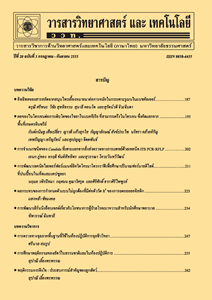การใช้คาร์บอนไดออกไซด์วิกฤตยิ่งยวดในการย้อมสีสิ่งทอและสังเคราะห์สีย้อมเอโซ
Main Article Content
Abstract
บทคัดย่อ
เนื่องจากการตระหนักถึงปัญหาที่เกิดขึ้นกับระบบนิเวศและกฎหมายด้านสิ่งแวดล้อมสำหรับกระบวนการผลิตทางอุตสาหกรรมที่มีความเข้มงวดมากขึ้นนั้น ช่วยกระตุ้นให้อุตสาหกรรมสิ่งทอ โดยเฉพาะอย่างยิ่งในส่วนของการย้อมสี มีการพัฒนาเทคโนโลยีที่ยั่งยืนเพื่อทดแทนกระบวนการย้อมสีแบบเดิมที่ใช้น้ำเป็นตัวกลาง การย้อมสีภายใต้คาร์บอนไดออกไซด์วิกฤตยิ่งยวดเป็นการย้อมสีแบบใหม่ที่ปราศจากน้ำ แต่ใช้คาร์บอนไดออกไซด์วิกฤตยิ่งยวดแทนการย้อมสีสิ่งทอด้วยคาร์บอนไดออกไซด์วิกฤตยิ่งยวดมีข้อดีกว่าการย้อมสีแบบทั่วไป คือ ช่วยลดการใช้น้ำในปริมาณสูงและลดการปล่อยน้ำเสีย นอกจากนี้ในแง่ประโยชน์ทางเศรษฐศาสตร์ยังช่วยประหยัดพลังงานและเพิ่มผลผลิตอีกด้วย คาร์บอนไดออกไซด์วิกฤตยิ่งยวดยังสามารถใช้เป็นตัวกลางในการสังเคราะห์สีย้อมเอโซได้อีกด้วย ทำให้ช่วยลดผลกระทบต่อสิ่งแวดล้อมที่เกิดจากการสังเคราะห์สีย้อม เช่น ลดปริมาณสีย้อม อิเล็คโตรไลท์ และโลหะหนักในน้ำทิ้ง
คำสำคัญ : คาร์บอนไดออกไซด์วิกฤตยิ่งยวด; การย้อมสีสิ่งทอ; สังเคราะห์สีย้อมเอโซ
Abstract
Due to the increasing consideration of ecological problem as well as more strict environmental legislation accounted for industrial processes have accelerated textile industry, especially, dyeing sector to develop sustainable technologies to replace a conventional aqueous dyeing process. Supercritical carbon-dioxide dyeing is a new dyeing method in which water is completely replaced by supercritical carbon-dioxide. Textile dyeing with supercritical carbon-dioxide gives many advantages when compared to conventional coloration methods, e.g. enormously reduces water consumption and wastewater emission. Furthermore, in term of economics benefits, it helps to increase energy saving and productivity. Supercritical carbon-dioxide can also be used as a medium in azo dyestuff synthesis. Consequently, the environment impact associated with dye synthesis is reduced, e.g. color, electrolyte and metals in effluent.
Keywords: supercritical carbon dioxide; textile coloration; azo dye synthesis


